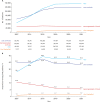The Epidemiology of Hepatitis B Virus Infection in Korea: 15-Year Analysis
- PMID: 38288536
- PMCID: PMC10825461
- DOI: 10.3346/jkms.2024.39.e22
The Epidemiology of Hepatitis B Virus Infection in Korea: 15-Year Analysis
Abstract
Background: The purpose of this study is to investigate the epidemiological changes in chronic hepatitis B (CHB) and assess the impact of coronavirus disease 2019 (COVID-19) over the past 15 years in a region endemic to hepatitis B virus (HBV).
Methods: National Health Insurance Service claims data of hepatitis B patients spanning from 2007 to 2021 was utilized. To compare the characteristics of the hepatitis B group, a control group adjusted for age and gender through propensity score matching analysis was established.
Results: The number of patients with CHB has consistently increased over the past 15 years. The average age of the CHB patient group has shown a yearly rise, while the prevalence of male dominance has gradually diminished. The proportions of hepatocellular carcinoma, liver cirrhosis, and decompensation have exhibited a declining pattern, whereas the proportion of liver transplants has continuously risen. Patients with CHB have demonstrated significantly higher medical and medication costs compared to the control group. Moreover, patients with CHB have shown a higher prevalence of comorbidities along with a significantly higher rate of concomitant medication usage. During the COVID period, the HBV group experienced a substantial decrease in the number of outpatient visits and overall medical costs compared to the control group.
Conclusion: The epidemiology of CHB has undergone significant changes over the past 15 years, encompassing shifts in prevalence, severity, medical costs, and comorbidities. Furthermore, the impact of COVID-19 has been observed to decrease healthcare utilization among patients with CHB when compared to controls.
Keywords: COVID-19 Infection; Epidemiology; HBV.
© 2024 The Korean Academy of Medical Sciences.
Conflict of interest statement
The authors have no potential conflicts of interest to disclose.
Figures



Comment in
-
Is the Prevalence of Chronic Hepatitis B Really Increasing in Korea?J Korean Med Sci. 2024 Jan 29;39(4):e59. doi: 10.3346/jkms.2024.39.e59. J Korean Med Sci. 2024. PMID: 38288545 Free PMC article. No abstract available.
Similar articles
-
Healthcare resource utilization and costs by disease severity in an insured national sample of US patients with chronic hepatitis B.J Hepatol. 2019 Jan;70(1):24-32. doi: 10.1016/j.jhep.2018.09.021. Epub 2018 Oct 1. J Hepatol. 2019. PMID: 30287341
-
Geographic distribution and characteristics of genotype A hepatitis B virus infection in acute and chronic hepatitis B patients in Japan.J Gastroenterol Hepatol. 2016 Jan;31(1):180-9. doi: 10.1111/jgh.13030. J Gastroenterol Hepatol. 2016. PMID: 26110395
-
Increasing comorbidities in a South Korea insured population-based cohort of patients with chronic hepatitis B.Aliment Pharmacol Ther. 2020 Jul;52(2):371-381. doi: 10.1111/apt.15867. Epub 2020 Jun 15. Aliment Pharmacol Ther. 2020. PMID: 32542860
-
Latest insights into the epidemiology, characteristics, and therapeutic strategies of chronic hepatitis B patients in indeterminate phase.Eur J Med Res. 2024 Jun 21;29(1):343. doi: 10.1186/s40001-024-01942-0. Eur J Med Res. 2024. PMID: 38902822 Free PMC article. Review.
-
Impact of NAFLD on the outcome of patients with chronic hepatitis B in Asia.Liver Int. 2022 Aug;42(9):1981-1990. doi: 10.1111/liv.15252. Epub 2022 Jul 7. Liver Int. 2022. PMID: 35373500 Review.
Cited by
-
Lower incidence of hepatocellular carcinoma with tenofovir alafenamide in chronic hepatitis B: Evidence from a large-scale cohort.JHEP Rep. 2024 Nov 12;7(2):101268. doi: 10.1016/j.jhepr.2024.101268. eCollection 2025 Feb. JHEP Rep. 2024. PMID: 39867683 Free PMC article.
-
Trends in alcohol use and alcoholic liver disease in South Korea: a nationwide cohort study.BMC Public Health. 2024 Jul 10;24(1):1841. doi: 10.1186/s12889-024-19321-z. BMC Public Health. 2024. PMID: 38987717 Free PMC article.
-
Hepatocellular carcinoma in Korea: an analysis of the 2016-2018 Korean Nationwide Cancer Registry.J Liver Cancer. 2025 Mar;25(1):109-122. doi: 10.17998/jlc.2025.02.20. Epub 2025 Mar 4. J Liver Cancer. 2025. PMID: 40033636 Free PMC article.
-
Is the Prevalence of Chronic Hepatitis B Really Increasing in Korea?J Korean Med Sci. 2024 Jan 29;39(4):e59. doi: 10.3346/jkms.2024.39.e59. J Korean Med Sci. 2024. PMID: 38288545 Free PMC article. No abstract available.
-
Global, Regional, and National Trends in Liver Disease-Related Mortality Across 112 Countries From 1990 to 2021, With Projections to 2050: Comprehensive Analysis of the WHO Mortality Database.J Korean Med Sci. 2024 Dec 2;39(46):e292. doi: 10.3346/jkms.2024.39.e292. J Korean Med Sci. 2024. PMID: 39623966 Free PMC article.
References
-
- Les I, García-Martínez R, Córdoba J, Quintana M, Esteban R, Buti M. Current trends in chronic hepatitis B management: results of a questionnaire. Eur J Gastroenterol Hepatol. 2009;21(10):1177–1183. - PubMed
-
- Perrillo RP, Marcellin P. Effect of newer oral antiviral agents on future therapy of chronic hepatitis B. Antivir Ther. 2010;15(1):13–22. - PubMed
-
- Liu LZ, Sun J, Hou J, Chan HL. Improvements in the management of chronic hepatitis B virus infection. Expert Rev Gastroenterol Hepatol. 2018;12(11):1153–1166. - PubMed
MeSH terms
Grants and funding
LinkOut - more resources
Full Text Sources
Medical
Miscellaneous

